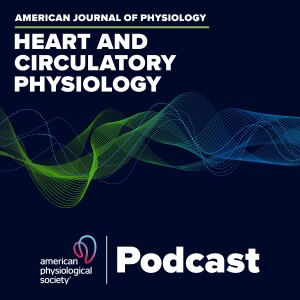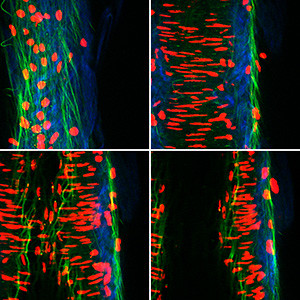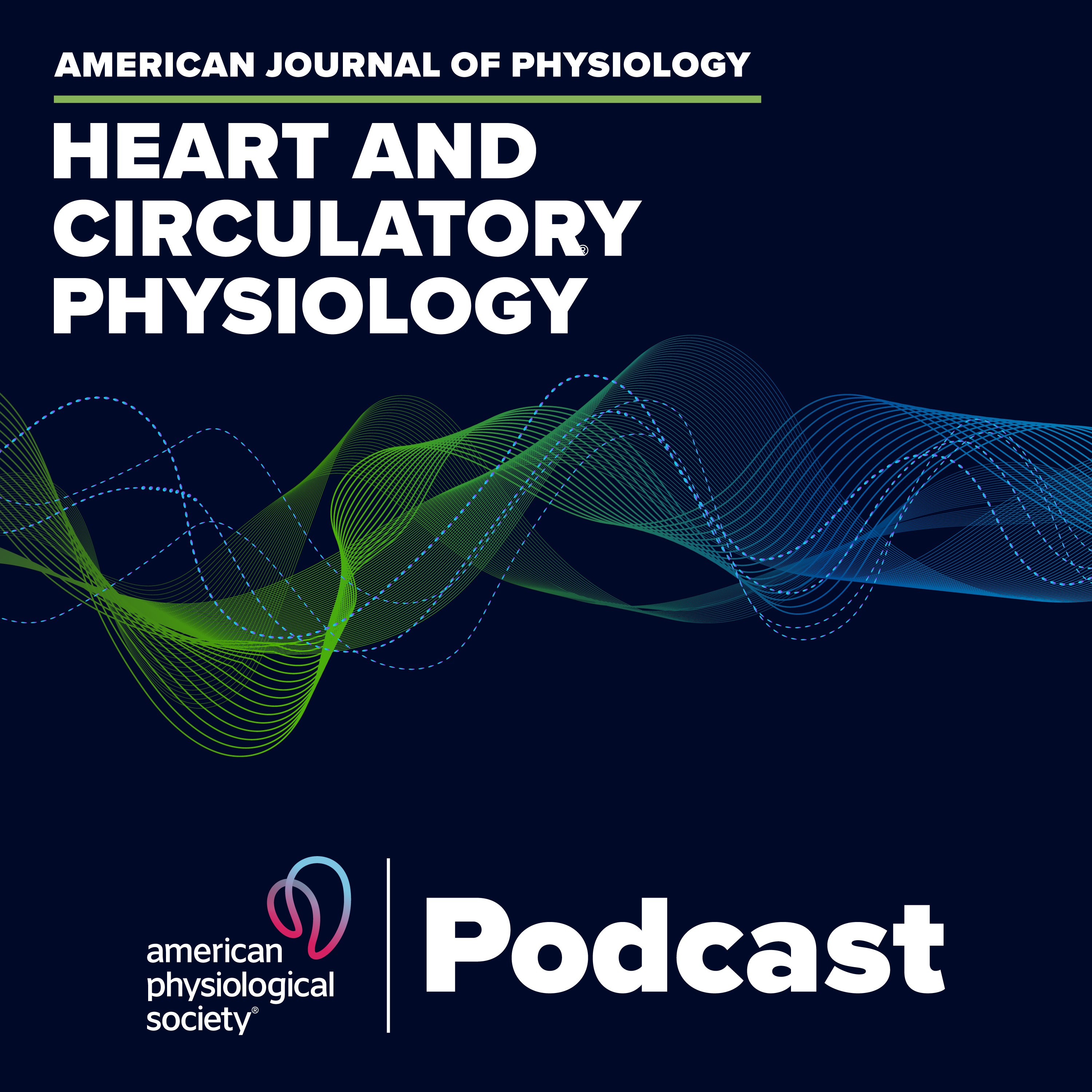Episodes

Wednesday Dec 05, 2018
Personalized Medicine in HFpEF
Wednesday Dec 05, 2018
Wednesday Dec 05, 2018
Why is biological phenotyping needed to improve current clinical treatment of heart failure with preserved ejection fraction (HFpEF)? Listen as Guest Editor Maria Bloksgaard (University of Southern Denmark) interviews lead author Vanessa van Empel (Maastricht University Medical Centre) and content expert Nicholas Houstis (Massachusetts General Hospital) about the new Review by Barandiarán Aizpurua et al, which points out that if we want to develop more personalized HFpEF treatments, we need greater understanding of the underlying pathophysiology of HFpEF. Can animal models of HFpEF “match” clinical phenotypes and accurately mimic exercise intolerance, congestive heart failure, and cardiovascular death experienced by HFpEF patients? Listen now and find out.
Arantxa Barandiarán Aizpurua, Blanche Schroen, Marc van Bilsen, and Vanessa P. M. van Empel Targeted HFpEF therapy based on matchmaking of human and animal models Am J Physiol Heart Circ Physiol, published September 21, 2018. DOI: 10.1152/ajpheart.00024.2018

Friday Oct 19, 2018
Statistical Considerations in Reporting Cardiovascular Research
Friday Oct 19, 2018
Friday Oct 19, 2018
“As biomedical scientists, we have an obligation to get the numbers right,” declares AJP-Heart and Circulatory Physiology Editor-in-Chief Dr. Irving H. Zucker in the opening of this insightful discussion on, that’s right, statistics. This isn’t your run-of-the-mill boring lecture on statistics, however. Listen as Irv Zucker (University of Nebraska Medical Center) interviews authors Merry L. Lindsey (University of Mississippi Medical Center), Gillian A. Gray (University of Edinburgh), Susan K. Wood (University of South Carolina School of Medicine), and Douglas Curran-Everett (National Jewish Health) about their new Guidelines in Cardiovascular Research article that provides clear, useful, and approachable guidance to authors and reviewers for reporting statistics in cardiovascular research. The authors discuss reporting precise p-values, using standard deviation rather than standard error, and looking beyond the t-test to more detailed analyses and visualization tools for processing datasets. This podcast is full of sage advice about planning statistical considerations early in the study design phase. “Being proactive rather than reactive will make the study stronger,” noted Merry Lindsey. Listen now for more from these experts.
Merry L. Lindsey, Gillian A. Gray, Susan K. Wood, and Douglas Curran-Everett Statistical Considerations in Reporting Cardiovascular Research Am J Physiol Heart Circ Physiol, published August 8, 2018. DOI: 10.1152/ajpheart.00309.2018

Tuesday Oct 16, 2018
Unregulated Ca2+ Cycling Exacerbates DMD Cardiomyopathy
Tuesday Oct 16, 2018
Tuesday Oct 16, 2018
Does improving intracellular calcium handling through cardiac-specific phospholamban ablation in a mouse model of Duchenne Muscular Dystrophy affect the development of cardiomyopathy? In this podcast, Associate Editor Junichi Sadoshima (Rutgers New Jersey Medical School) interviews first author Michelle Law (University of Minnesota) and content expert Sakthivel Sadayappan (University of Cincinnati) about the new study by Law and co-authors. Using the mdx mouse model, phospholamban ablation was studied in the context of dystrophic cardiomyopathy. Law et al found that although calcium cycling was enhanced in myocytes, DMD cardiomyopathy was surprisingly worsened in vivo. Given that there are both calcium mishandling and mechanical stress components to DMD cardiomyopathy, do the authors suspect that unregulated Serca2a pump function damaged the sarcolemma and increased fibrosis and myocyte death? Listen and find out.
Michelle L Law, Kurt W Prins, Megan E Olander, and Joseph M Metzger Exacerbation of dystrophic cardiomyopathy by phospholamban deficiency-mediated chronically increased cardiac Ca2+ cycling in vivo Am J Physiol Heart Circ Physiol, published August 17, 2018. DOI: 10.1152/ajpheart.00341.2018

Friday Oct 12, 2018
Sex Differences in Depression-Like Behavior Post Myocardial Infarction
Friday Oct 12, 2018
Friday Oct 12, 2018
Nearly one-fifth of heart failure patients develop depression or depression-like symptoms and are therefore at greater risk for additional cardiac events and mortality. Inflammation in the hypothalamus has been shown to play a role in heart failure progression and depression. Is there also a link between the presence, or absence, of estrogens in the brain and heart failure comorbid with depression? In this special extended-length podcast, Associate Editor Kaushik Patel (University of Nebraska Medical Center) interviews senior author Frans H.H. Leenen (University of Ottawa Heart Institute) and content expert Adam Case (University of Nebraska Medical Center). Past clinical studies have clearly shown that post-menopausal women with heart failure are at higher risk for developing depression compared to premenopausal women. Disappointed with previous animal studies performed only in male rats, Leenen and co-authors embarked on designing new animal studies to specifically address sex differences. Najjar et al reported that young female rats were protected from depression by the presence of estrogens, compared to both male rats and post-menopausal female rats. Listen now as our experts discuss these novel studies as well as the interplay of peripheral inflammation, central inflammation, and cardiac sympathetic afferent pathways in the development of depression with heart failure.
Fatimah Najjar, Monir Ahmad, Diane Lagace, and Frans H.H. Leenen Sex Differences in Depression-Like Behavior and Neuroinflammation in Rats Post MI: Role of Estrogens Am J Physiol Heart Circ Physiol, published July 27, 2018. DOI: 10.1152/ajpheart.00615.2017

Friday Sep 14, 2018
Piezo1 Mechanotransduction in the Uterine Circulation
Friday Sep 14, 2018
Friday Sep 14, 2018
Is the Piezo1 cation channel the sensor for shear stress that triggers uterine blood vessel growth and vasodilation in pregnancy? Listen as Editor in Chief Irving H. Zucker (University of Nebraska Medical Center) interviews lead author George Osol (University of Vermont College of Medicine) and content expert Kirk Conrad (University of Florida University of Florida College of Medicine) about the new study by John et al that explores the presence of Piezo1 in the uterine circulation, and the channel’s response to shear stress and the link to nitric oxide in both pregnant and non-pregnant uterine arteries. In the context of pregnancy, might a defect in Piezo1 expression or physiology trigger trophoblast invasion and spiral artery remodeling which lead to preeclampsia? Listen and learn more.
Liam John, Nga Ling Ko, Alexander Gokin, Natalia Gokina, Maurizio Mandala, and George Osol The Piezo1 Cation Channel Mediates Uterine Artery Shear Stress Mechanotransduction and Vasodilation During Rat Pregnancy Am J Physiol Heart Circ Physiol, published July 13, 2018. DOI: 10.1152/ajpheart.00103.2018

Saturday Sep 01, 2018
Vascular Smooth Muscle Actin Depolymerization
Saturday Sep 01, 2018
Saturday Sep 01, 2018
Is actin depolymerization the mechanism that causes vasodilation in small resistance arterioles? Listen as Associate Editor Robert Hester (University of Mississippi Medical Center) and content expert William Jackson (Michigan State University) interview lead author Philip Clifford (University of Illinois at Chicago) about the new study by Clifford et al. Using two different vasodilators with two different mechanisms of action, Clifford and co-authors found that there was an increase in the G-actin to sm22apha ratio, signaling a reduction in the amount of F-actin in the cell. Both vasodilators investigated-- pinacidil and sodium nitroprusside—act partially through an actin depolymerization. However, sodium nitroprusside is more dependent on this mechanism to achieve vasodilation. What is the time course of this change in actin polymerization? Is depolymerization essential for vasodilation, or a by-product of vasodilation? Listen to our experts and find out.
Philip S. Clifford, Brian S. Ferguson, Jeffrey L. Jasperse, and Michael A. Hill Arteriolar vasodilation involves actin depolymerization Am J Physiol Heart Circ Physiol, published August 8, 2018. DOI: 10.1152/ajpheart.00723.2017

Tuesday Aug 28, 2018
Reversal of Microvascular Dysfunction
Tuesday Aug 28, 2018
Tuesday Aug 28, 2018
Can existing vascular disease be reversed? Listen as Associate Editor Robert Hester (University of Mississippi Medical Center) interviews lead author Jefferson Frisbee (University of Western Ontario) and content expert Geraldine Clough (University of Southampton) about the novel new work by Lemaster et al, which utilized a chronically obese animal model to attempt to reverse established vascular dysfunction rather than blunt disease development. After treatment with chronic atorvastatin, or chronic treadmill exercise, or both, Frisbee and colleagues observed improvement in endothelial function, however with some residual vasculopathy. What unique insights were gained by using a multi-scale approach from whole animal to isolated tissues? Do these observations have translational implications for treatment of microvascular dysfunction in patients? Listen and find out.
Kent A Lemaster, Stephanie J Frisbee, Luc DuBois, Nikolaos Tzemos, Fan Wu, Matthew T Lewis, Robert W. Wiseman, and Jefferson C. Frisbee Chronic Atorvastatin and Exercise Can Partially Reverse Established Skeletal Muscle Microvasculopathy in Metabolic Syndrome Am J Physiol Heart Circ Physiol. Published June 22, 2018. DOI: 10.1152/ajpheart.00193.2018

Wednesday Aug 08, 2018
Fibroblast Phenotypic Changes in the Aging Heart
Wednesday Aug 08, 2018
Wednesday Aug 08, 2018
Why is it important to understand resident cardiac fibroblasts and how they change with aging? In this thought-provoking podcast, Deputy Editor Merry Lindsey (University of Mississippi Medical Center) interviews lead author Katarzyna Cieslik (Baylor College of Medicine) and content expert Michael Czubryt (University of Manitoba) about the insightful Review article by Trial and Cieslik. Fibroblasts are no longer considered mere support cells producing matrix protein, explains Cieslik. Rather, fibroblasts have complex physiology and a phenotype altered by aging. Listen as our experts unravel the many faces of fibroblasts, from promoting inflammation to producing extracellular matrix protein. Can observations made in young healthy fibroblasts be extrapolated across ages and pathologies? Listen and find out.
JoAnn Trial and Katarzyna A. Cieslik Changes in Cardiac Resident Fibroblast Physiology and Phenotype in Aging Am J Physiol Heart Circ Physiol, published June 15, 2018. DOI: 10.1152/ajpheart.00237.2018

Wednesday Jul 18, 2018
Japanese Language Podcast: Type of Resistance Exercise and Endothelial Function
Wednesday Jul 18, 2018
Wednesday Jul 18, 2018
In this special Japanese-language podcast, we explore an important exercise physiology question: Can high-intensity resistance exercise, combined with low repetitions, maintain endothelial function? Listen as Associate Editor Masafumi Kitakaze (National Cerebral and Cardiovascular Center, Japan) interviews lead author Takuma Morishima (Hosei University, Japan) and content expert Osamu Tsukamoto (Osaka University, Japan) about the novel work by Morishima and co-authors. By studying young, healthy male volunteers, the authors found that both moderate-intensity resistance exercise with moderate repetitions, and low-intensity resistance exercise with high repetitions caused significant impairment in endothelial function. In stark contrast, the authors found that high-intensity resistance exercise with low repetitions prevents endothelial dysfunction. While these findings offer key insights for young, healthy men participating in resistance exercise programs, what are the implications for older adults, women, and hypertension patients? Listen and find out.
Takuma Morishima, Yosuke Tsuchiya, Motoyuki Iemitsu, and Eisuke Ochi High-intensity resistance exercise with low repetitions maintains endothelial function Am J Physiol Heart Circ Physiol, published June 1, 2018. DOI: 10.1152/ajpheart.00281.2018

Wednesday Jul 18, 2018
Type of Resistance Exercise and Endothelial Function
Wednesday Jul 18, 2018
Wednesday Jul 18, 2018
Can high-intensity resistance exercise, combined with low repetitions, maintain endothelial function? Listen as Associate Editor Masafumi Kitakaze (National Cerebral and Cardiovascular Center, Japan) interviews lead author Takuma Morishima (Hosei University, Japan) and content expert Osamu Tsukamoto (Osaka University, Japan) about the novel work by Morishima and co-authors. By studying young, healthy male volunteers, the authors found that both moderate-intensity resistance exercise with moderate repetitions, and low-intensity resistance exercise with high repetitions caused significant impairment in endothelial function. In stark contrast, the authors found that high-intensity resistance exercise with low repetitions prevents endothelial dysfunction. While these findings offer key insights for young, healthy men participating in resistance exercise programs, what are the implications for older adults, women, and hypertension patients? Listen and find out.
Takuma Morishima, Yosuke Tsuchiya, Motoyuki Iemitsu, and Eisuke Ochi High-intensity resistance exercise with low repetitions maintains endothelial function Am J Physiol Heart Circ Physiol, published June 1, 2018. DOI: 10.1152/ajpheart.00281.2018

